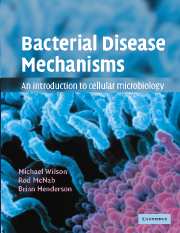Book contents
- Frontmatter
- Contents
- Preface
- Abbreviations used
- Chapter 1 An introduction to bacterial diseases
- Chapter 2 Bacterial cell biology
- Chapter 3 Molecular analysis of bacterial virulence mechanisms
- Chapter 4 Communication in infection
- Chapter 5 The mucosal surface: the front line of antibacterial defence
- Chapter 6 Immune defences against bacteria
- Chapter 7 Bacterial adhesion as a virulence mechanism
- Chapter 8 Bacterial invasion as a virulence mechanism
- Chapter 9 Bacterial exotoxins
- Chapter 10 Bacterial evasion of host defence mechanisms
- Chapter 11 Bacteria in human health and disease: the future?
- Appendix A Glossary of terms used
- Appendix B Brief descriptions of bacteria frequently mentioned
- Index
- Plate section
Chapter 9 - Bacterial exotoxins
Published online by Cambridge University Press: 05 June 2012
- Frontmatter
- Contents
- Preface
- Abbreviations used
- Chapter 1 An introduction to bacterial diseases
- Chapter 2 Bacterial cell biology
- Chapter 3 Molecular analysis of bacterial virulence mechanisms
- Chapter 4 Communication in infection
- Chapter 5 The mucosal surface: the front line of antibacterial defence
- Chapter 6 Immune defences against bacteria
- Chapter 7 Bacterial adhesion as a virulence mechanism
- Chapter 8 Bacterial invasion as a virulence mechanism
- Chapter 9 Bacterial exotoxins
- Chapter 10 Bacterial evasion of host defence mechanisms
- Chapter 11 Bacteria in human health and disease: the future?
- Appendix A Glossary of terms used
- Appendix B Brief descriptions of bacteria frequently mentioned
- Index
- Plate section
Summary
Aims
The principal aims of this chapter are:
to describe the various categories of bacterial exotoxins and their cellular effects
to provide examples of toxins from each category and their role in pathogenesis
to emphasise that exotoxins may have subtle effects at low concentrations that do not cause target cell death
to describe the role that exotoxins have played in the dissection of eukaryotic signalling pathways
to highlight some therapeutic uses of exotoxins
Introduction
Bacterial exotoxins are a diverse collection of proteins responsible for many of the symptoms caused by pathogens during infection. Exotoxins are actively exported by bacteria or else are released on cell lysis. Some toxins can kill cells outright by a number of different means. Others interfere with fundamental cellular activities to the ultimate benefit of the bacterium.
A number of bacteria produce a barrage of toxic activities, some of which may appear at first glance to be ‘blunt instruments’. These include toxins that degrade host cell membrane components, and the channel-forming toxins that punch holes in target cell membranes. Closer inspection of some of these toxins, however, reveals an underlying degree of sophistication in function that may result, for example, in interference with host immune defence mechanisms. Other toxins are perhaps more analogous to the stiletto dagger, being exquisitely specific in their target selection. This is perhaps best exemplified by the clostridial neurotoxins.
- Type
- Chapter
- Information
- Bacterial Disease MechanismsAn Introduction to Cellular Microbiology, pp. 466 - 513Publisher: Cambridge University PressPrint publication year: 2002
- 1
- Cited by



